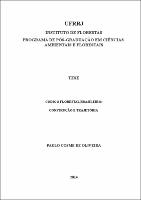Please use this identifier to cite or link to this item:
https://rima.ufrrj.br/jspui/handle/20.500.14407/9370| Tipo do documento: | Tese |
| Title: | Código Florestal brasileiro : construção e trajetória |
| Other Titles: | Brazilian Forest Code: construction and trajectory |
| Authors: | Oliveira, Paulo Cosme de |
| Orientador(a): | Silva, José de Arimatéa |
| Primeiro membro da banca: | Silva, José de Arimatéa |
| Segundo membro da banca: | Pereira, Ana Carolina Callegario |
| Terceiro membro da banca: | Collares, José Enilcio Rocha |
| Quarto membro da banca: | Paula Filho, Afranio Faustino de |
| Quinto membro da banca: | Silva, Eduardo Vinicius |
| Keywords: | Legislação Florestal;Política Florestal;Instrumentos legais;Forest Law;Forest Policy;Legal Instruments |
| Área(s) do CNPq: | Recursos Florestais e Engenharia Florestal |
| Idioma: | por |
| Issue Date: | 27-Feb-2014 |
| Publisher: | Universidade Federal Rural do Rio de Janeiro |
| Sigla da instituição: | UFRRJ |
| Departamento: | Instituto de Florestas |
| Programa: | Programa de Pós-Graduação em Ciências Ambientais e Florestais |
| Citation: | OLIVEIRA, Paulo Cosme de. Código Florestal brasileiro : construção e trajetória. 2014. 105 f. Tese (Doutorado em Ciências Ambientais e Florestais) - Instituto de Florestas, Universidade Federal Rural do Rio de Janeiro, Seropédica, 2014 . |
| Abstract: | Esta pesquisa teve como objetivo geral: descrever a trajetória da lei federal conhecida como Código Florestal, desde a sua origem em janeiro de 1934 a outubro de 2012, quando sofreu as últimas modificações. Os objetivos específicos foram: i) Resgatar e discutir os processos de construção da norma, nas suas três versões; ii) Sumarizar a inserção do tema florestas nos textos constitucionais; iii) Analisar a estrutura do Código Florestal, nas suas versões, e principais mudanças nele promovidas no decorrer da sua trajetória; iv) Elencar e associar as leis federais relevantes conexas à temática do Código Florestal. Analisou-se a estrutura e mudanças dos três pergaminhos legislativos: o Código de 1934, Decreto nº 23.793; o (novo) Código de 1965;a Lei nº 4.771, suas alterações ao longo de 45 anos de vigência; a atual Lei de Proteção da Vegetação Nativa, Lei nº 12.651, de 2012, também intitulada de novo Código Florestal. As principais conclusões foram: existe farta literatura, principalmente jurídica, sobro e o Código Florestal, mas o conhecimento sobre a construção e trajetória da norma não fora ainda sistematizado para consumo acadêmico; das sete constituições brasileiras, as duas primeiras não trataram do tema florestas, e todas as outras, a partir da de 1934 acolheram-no, consolidandoo na atual Constituição (1988); embora muitas mudanças tenham sido promovidas nos textos dos Códigos, uma estrutura geral é visível nas três versões da Lei: áreas de não uso, de uso restrito, passíveis de manejo florestal e áreas passíveis de supressão total; existe uma vasta legislação conexa à temática florestal, podendo-se destacar a Política Nacional do Meio Ambiente, o Sistema Nacional de Gerenciamento de Recursos Hídricos, o Sistema Nacional de Unidades de Conservação da Natureza, a Lei de Gestão de Florestas Públicas e a Lei de “Crimes Ambientais”. |
| Abstract: | This research investigation aims to describe the trajectory of the federal law known as the Forest Code, since its inception in January 1934 through October 2012, when it has suffered the latest modifications. The specific objectives were: i) To collect and discuss the processes of construction of the standard, in its three versions; ii) summarize the inclusion of the forests topic in constitutional texts; iii) analyze the structure of the Forest Code in their versions, and major changes it promoted in the course of its career ; iv) to list and associate the relevant federal laws related to the theme of the Forest Code. We analyzed the structure and legislative changes of the three scrolls : the Code of 1934 , Decree 23793, the (new) Code 1965, Act no. 4771, their changes over 45 years of operation, the current Law on the Protection of Native Vegetation , Law no . 12651, 2012, also titled the new Forest Code. The main conclusions were: there is abundant literature, mainly legal, oak forests and the Forest Code, but knowledge about the construction and history of the rule was not yet systematized for academic consumption; among seven Brazilian constitutions, the first two have not addressed the issue of forests, and all others, from the 1934 welcomed them in, consolidating it in the current Constitution (1988);although many changes have been promoted in the texts of codes, a general framework is visible in all three versions of Law: areas of non-use, restricted use, subject to forest management and areas for total withdrawal; there is extensive legislation related to forest theme, maybe noted the National Environmental Policy Act , the National System for Water Resources Management, the National System of Units Conservation of Nature, the Public Forest Management Law and the Law of " Environmental Crimes". |
| URI: | https://rima.ufrrj.br/jspui/handle/20.500.14407/9370 |
| Appears in Collections: | Doutorado em Ciências Ambientais e Florestais |
Se for cadastrado no RIMA, poderá receber informações por email.
Se ainda não tem uma conta, cadastre-se aqui!
Files in This Item:
| File | Description | Size | Format | |
|---|---|---|---|---|
| 2014 - Paulo Cosme de Oliveira.pdf | Paulo Cosme de Oliveira | 822.51 kB | Adobe PDF |  View/Open |
Items in DSpace are protected by copyright, with all rights reserved, unless otherwise indicated.

